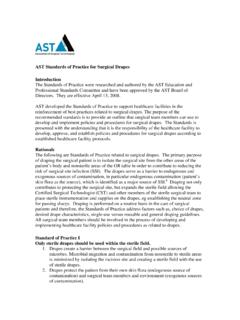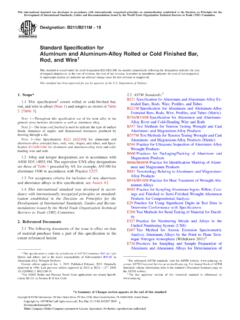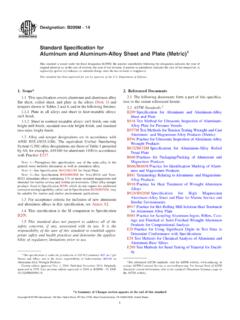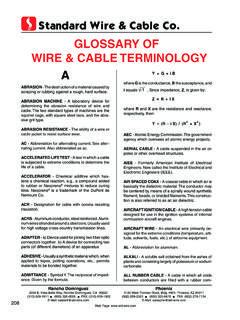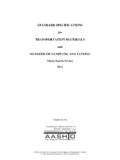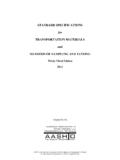Transcription of Chain Link Fence Manufacturers Institute Product Manual
1 Copyright 2011. All rights reserved Chain Link Fence Manufacturers Institute 10015 Old Columbia Road Suite B215 Columbia, MD 21046 Chain Link Fence Manufacturers Institute Product Manual CLF-PM0610 (revised July, 2011) Table of Contents How to Use the Product Manual 1 Description of Terms 2 Table 1 - Breaking Strength of Steel Wire 3 Table 2 -Thickness of ASTM F668 Fabric Polymer Coating 3 Table 3 - Standard Mesh Sizes and Gauges for Chain Link Fabric 4 Table 4 - Small Mesh Sizes and Wire Gauges for Metallic Coated Chain Link Fabric 5 Table 5 - Small Mesh Sizes for Wire Gauges for Polymer Coated Chain Link Fabric 6 Table 6 - Galvanized Steel Post Dimensions and Strength Characteristics 7 Table 7 - Guide for Selection of ASTM F 1043 Line Post 8 Drawings
2 Typical Fence Section - Top Rail/Trussed Brace Rail with Bottom Tension Wire 9 Typical Fence Section - Trussed Brace Rail w/Top & Bottom Tension Wire 10 Typical Fence Elevation Top Rail/Trussed Brace Rail w/ Bottom Tension Wire 11 Typical Fence Elevation Trussed Brace Rail; 3 Stands Barbed Wire w/ Top & Bottom Tension Wire 12 Typical Fence Elevation Top Rail/Trussed Brace Rail 3 Stands Barbed Wire & Bottom Tension Wire 13 Typical Swing Gate Three Strands Barbed Wire (OPTIONAL) 14 Typical Double Swing Gate Three Strands Barbed Wire (OPTIONAL) 15 Single Cantilevered Sliding Gate Round Posts w/ Barbed Wire (6 thru 22 openings) 16 Single Cantilevered Sliding Gate Round Posts w/ Barbed Wire (10 thru 30 )
3 17 CLFMI GUIDE FOR SPECIFYING COMMERCIAL, INDUSTRIAL, AND SECURITY Chain LINK Fence AND GATES ( Contract Section 32 31 13) Addendum (Note: For a copy of this specification in Word format please contact CLFMI Headquarters) Chain LINK Fence MANUFACTUTERS Institute Product Manual (CLF PM2445) The purpose of this Manual is to provide Chain link Fence technical information for general knowledge, system design or the development of a commercial/industrial/security Chain link Fence specification.
4 HOW TO USE THE CLFMI Product Manual a. Familiarize yourself with the content of the CLFMI Product Manual . b. The Product Manual includes drawings of the four standard Chain link Fence designs plus swing gate, cantilever slide gate and fitting/assembly details. c. Review the different Chain link fabric configurations and gauges to ensure the best selection of the mesh size and wire gauge for the application. d. Prior to designing a security Fence system read the CLFMI Security Fencing Recommendations SFR2445 . e. Select the type of fabric for the application; galvanized (ASTM A392), aluminum coated (ASTM A491), zinc 5% mischmetal alloy (ASTM F1345) or polymer coated (ASTMF 668).
5 F. Review the framework Dimensions and Strength Characteristics Table # 6 and Guide for Selection of Line Post, Table # 7 to select the post that best suits the application, (ASTM F1043 and ASTM F1083). Make sure to take into consideration wind load particularly if the Fence is 8 ft. high or greater using 1 in. mesh or less. Use the CLFMI Chain Link Fence Wind Load Guide for the Selection of Line Post and Line Post Spacing WLG2445 for a Fence requiring a structural framework design due to wind load. g. For polymer coated fabric or systems choose an ASTM color from ASTM F934.
6 H. Thoroughly review and understand the Chain link ASTM standards ; those reference above as well as; Chain link terminology (F552), fittings and tie wire (F626), barbed wire (A121 and F665), barbed tape (F1910 and F1911) tension/coil spring wire (A824 and F1644), swing gates (F900), horizontal slide gates (F1184), automated vehicular gates (F2200), and Chain link installation (F567). i. The CLFMI Manual includes a CSI formatted Chain link Fence specification, Commercial, Industrial and Security Chain Link Fence and Gates, Section 32 31 13 for use in designing and specifying a Chain link Fence system.
7 J. For light industrial/commercial applications select framework form ASTM F1043 Table 4 Summary of Requirements for Light Industrial/Commercial Fence Framework . k. All phases of Chain link Fence installation are covered in detail within the Specification 32 31 13, Part 3. 1 DESCRIPTION OF TERMS A short list of descriptive terms: (See ASTM F552, Standard Terminology Relating to Chain Link Fencing for a complete list.) a. Chain link fabric A fencing material consisting of wire helically wound and interwoven in such a manner as to provide a continuous mesh without kn ots or ties except in the form of knuckling or twisting at the top and bottom of the mesh to form the fabric selvage.
8 B. Selvage The top and bottom edge finish on woven Chain link formed by joining adjacent pairs of wire pickets. The selvage may be knuckled or twisted. c. Knuckled selvage* refers to bending the adjacent pairs of wire back into a tight loop. d. Twisted selvage* refers to twisting the adjacent pairs of wire together in a close helix of 1 machine turns, which is equivalent to three full twists. e. Mesh size The minimum clear distance between the wires forming the parallel sides of the mesh. f. Terminal post A post to which the Chain link fabric is terminated using specific fittings; end post, corner post, gate post and pull post (a terminal post used to accommodate a grade or placed at intervals on long stretches of Fence ).
9 G. Line post Intermediate posts set no greater than 10 feet on center between the terminal posts. h. See drawing Typical Fence Section for details of various Fence fittings; tension bar, truss rod, tension band, brace band, rail end and barb arm. KNUCKLE SELVAGE* TWIST SELVAGE* *Adapted, with permission from the Annual Book of standards , copyright ASTM International, 100 Barr Harbor Drive, West Conshohocken, PA 19248 2 TABLE 1 BREAKING STRENGTH OF STEEL WIRE 6 gauge [ mm] 2170 lbf [9650 N]
10 9 gauge [ mm] 1290 lbf [5740 N] 11 gauge [ mm] 850 lbf [3780 N] 11 gauge [ mm] 750 lbf [3340 N] 12 gauge [ mm] 650 lbf [2890 N] 14 gauge [ mm] 380 lbf [1690 N] TABLE 2 THICKNESS OF ASTM F668 FABRIC POLYMER COATING Minimum/Maximum Class 1 & Class 2a Class 2b Minimum @ any point in.





